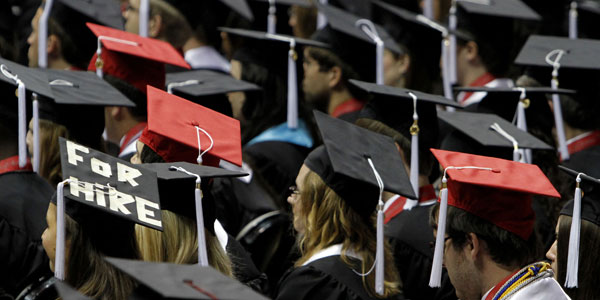While consolidating or refinancing your student loans may be a wise idea financially, knowing which bank or lender to go through for carrying out the actual transaction can be confusing. This is because there are a number of different variables to consider when refinancing or consolidating your student loans in 2020.
Interest rates and loan terms are two of the key criteria that you should keep top of mind. However, the actual financial institution that you go through can also make a difference. With that in mind, it is important to compare several lenders prior to finalizing the transaction.
Below is a comparison of the best banks and lenders to help you refinance and consolidate both private and federal student loans. For a holistic review, we discuss student loan consolidation and refinance rates, terms, loan types, eligible degrees and everything you’ll need to make a decision on the best company to work with.

SoFi Review
At SoFi, both federal and private student loan debt can be either consolidated or refinanced. As a borrower, you are offered a wide range of variable and fixed interest rates to choose from. There are no origination fees or prepayment penalties, so additional borrowing costs are kept to a minimum.
 SoFi also offers additional benefits to its borrowers. For example, with unemployment protection, if you lose your job while you still have a student loan balance, SoFi will temporarily pause your payments and even assist you in finding a new job by reviewing your resume, as well as offering you interview coaching and various tactics for negotiating, which can help you to get back on your “financial feet” more quickly.
SoFi also offers additional benefits to its borrowers. For example, with unemployment protection, if you lose your job while you still have a student loan balance, SoFi will temporarily pause your payments and even assist you in finding a new job by reviewing your resume, as well as offering you interview coaching and various tactics for negotiating, which can help you to get back on your “financial feet” more quickly.
If you opt to refinance your student loan, the entire process can take place online and it can be completed in as little as 15 minutes. All it takes is a quick pre-approval in order to ensure that you qualify. Once that is complete, you can choose a loan that fits your specific requirements and then just sign and upload the documents.
Earnest Review
Earnest is known for its flexibility in student loan refinancing and consolidation. With this lender’s Precision Pricing, you are able to choose the monthly payment that works the best for you and your personal budget. Earnest also looks forward when determining your overall financial picture – not just backward.
 This means that rather than just evaluating your past financial and credit history, they also look forward and take into consideration your future financial potential and responsibility. This makes their loan underwriting that much more personal.
This means that rather than just evaluating your past financial and credit history, they also look forward and take into consideration your future financial potential and responsibility. This makes their loan underwriting that much more personal.
Furthermore, unlike most other lenders that transfer your loan to a third party servicer soon after receiving your paperwork, Earnest stays with you throughout the life of the loan. With that in mind, you can expect personal service – now and in the future.
CommonBond Review
CommonBond offers you the option to choose from fixed, variable, or hybrid interest rates. Hybrid rates allow you to pay a fixed rate on your loan for the first five years, and then pay variable rates for the last five years.
 There are no hidden fees to contend with such as application fees, origination fees, or even prepayment penalties if you pay your loan off early. You are also protected from various financial “emergencies” such as job loss. For example, if you lose your job, CommonBond will pause your student loan payments – and will even assist you in finding new employment.
There are no hidden fees to contend with such as application fees, origination fees, or even prepayment penalties if you pay your loan off early. You are also protected from various financial “emergencies” such as job loss. For example, if you lose your job, CommonBond will pause your student loan payments – and will even assist you in finding new employment.
The process of consolidation or refinance is easy – and in most cases can be completed entirely online in just four steps. Just simply fill out the application, obtain your interest rate, upload the necessary documents, and wait for an approval.
Citizens Bank Review
Citizens Bank provides the opportunity to refinance high student loan debt or to consolidate multiple loans. This lender offers ways to get a lower interest rate, regardless of whether you are consolidating or refinancing student loans through them.
 These can include automatic payments, which is when you authorize the Citizens Bank loan servicer to automatically deduct your monthly loan payments, you can save 0.25% off your student loan’s interest rate. Or a loyalty discount, which applies if you (or a cosigner) already has a qualifying account with Citizens Bank at the time that you apply, you may also be able to save 0.25% on a new Education Refinance Loan.
These can include automatic payments, which is when you authorize the Citizens Bank loan servicer to automatically deduct your monthly loan payments, you can save 0.25% off your student loan’s interest rate. Or a loyalty discount, which applies if you (or a cosigner) already has a qualifying account with Citizens Bank at the time that you apply, you may also be able to save 0.25% on a new Education Refinance Loan.
If you have poor (or no) credit, then applying for a loan consolidation or a refinance in conjunction with a cosigner may help your chances of approval. It can also help you to obtain a lower interest rate – which, in turn, can help to lower your monthly payment amount. At Citizens Bank, even if you apply along with a cosigner, once you have made 36 consecutive on-time payments on your loan, you can apply to release your cosigner from your loan.
LendKey Review
LendKey offers a way for borrowers and more than 13,000 credit unions and community financial institutions to essentially “match up” and find the best solution for all. This can help you to discover the option that works for your specific budget and payment schedule – all from the convenience of your computer.
 Because of the transparent, low-interest lending structure of these types of financial institutions, you can make smart borrowing decisions when it comes to consolidating or refinancing your student loans through LendKey – which can essentially help you in lowering your interest rate, your monthly payment amount, and in turn, your overall lifetime payment that is due.
Because of the transparent, low-interest lending structure of these types of financial institutions, you can make smart borrowing decisions when it comes to consolidating or refinancing your student loans through LendKey – which can essentially help you in lowering your interest rate, your monthly payment amount, and in turn, your overall lifetime payment that is due.
With LendKey, you will not be subject to paying any loan origination fees, or early loan payoff penalties, either. This can end up saving you thousands of extra dollars throughout the life of your student loan.
DRB Review
DRB offers borrowers both fixed and variable interest rates, with payment terms that range from between 5 and 20 years. If you happen to lose your job, DRB will allow you to cease making payments on your student loan during the time of your hardship – and they will even provide you with assistance in finding new employment.
 Through this lender, you may be able to refinance up to 100% of your outstanding federal and private student loans. There are no origination fees, and no prepayment penalties if you pay off your loan early.
Through this lender, you may be able to refinance up to 100% of your outstanding federal and private student loans. There are no origination fees, and no prepayment penalties if you pay off your loan early.
The Bottom Line
When considering a lender for a student loan consolidation or refinance, it is typically best to compare several prior to making your ultimate decision. It is important to note that the actual interest rate that you will receive on your loan will be based upon several factors that are specific to you and your unique background, including your income, credit score, and savings. Whether or not you apply with a cosigner can also be a factor.








